Global Greenhouse Gas Emissions and Land Use Impacts of Soybean Production: Systematic Review and Analysis
Abstract
1. Introduction
2. Materials and Methods
2.1. Study Design
2.2. Systematic Review
- (a)
- Publication in refereed academic journals, ensuring data quality, transparency, and methodological rigor;
- (b)
- Publication between 2010 and 2024, reflecting recent production systems;
- (c)
- Inclusion of LCA data with quantified inventories of farm operations and material/energy use;
- (d)
- Data specifically for soybean production.
2.3. Inventory Database Construction
- Process Information: Included the country, climate, cultivation area, operations, crop rotation, or secondary crop information.
- LCA Methods: Covered the standardization methodologies, system boundaries (cradle-to-gate), functional units, allocation methods, and modeling approaches used in each study.
- LCI Input Data: Included fertilizers (nitrogen, phosphorus, and potassium), herbicides, insecticides, energy consumption (diesel and electricity), agrochemical use, and crop residue management.
- LCI Output Data: Focused on GHG emissions flows (CO2 and N2O), land, energy outputs, and yields.
- Results: Included the environmental indicators used in each study, such as GWP, water use (blue, green, and grey water), and depletion of fossil resources.
2.4. Impact Assessment
2.4.1. Farm-Level Emissions
N2O Emissions from Managed Soils
CO2 Emissions from Soil Management
2.4.2. Impact Assessment Model
2.4.3. Indirect Emissions from Field Operations
2.4.4. Assessment of Land Use Impacts
2.5. Data Analysis
3. Results and Discussion
3.1. PRISMA Systematic Review
3.2. Inventory Database
3.3. Data Analysis Results
3.3.1. Emissions Overview
3.3.2. Correlation Analysis
3.3.3. Differences Between Farms in Each Country
Emissions Distribution by Country
Countries with High-GWP Farms: Iran, Italy, and the United States
Countries with Low-GWP Farms: Argentina and Brazil
Climate, Technical, and Policy Conditions
3.3.4. Identifying Best Practices
3.3.5. Land Use Impact
3.4. Comparison with the Literature
3.5. Assumptions and Limitations
3.5.1. Lack of Detailed Information on Crop Residue Management
3.5.2. Absence of Climate, Soil Type, and Geographical Data
3.5.3. Limited Sample Size for Organic Farming Systems
3.5.4. Gaps in Input Data and Variability in Data Quality
3.5.5. Limitation in Regional Representation
3.5.6. Potential Gaps in Literature Coverage
3.6. Methodological Framework Strengths
3.7. Policy Implications
4. Conclusions
Supplementary Materials
Author Contributions
Funding
Institutional Review Board Statement
Informed Consent Statement
Data Availability Statement
Conflicts of Interest
Abbreviations
| LCA | Life Cycle Assessment |
| GHG | Greenhouse Gas |
| IPCC | Intergovernmental Panel on Climate Change |
| PRISMA | Preferred Reporting Items for Systematic Reviews and Meta-Analyses |
| LU | Land Use |
| LUC | Land Use Change |
References
- Vermeulen, S.J.; Campbell, B.M.; Ingram, J.S.I. Climate Change and Food Systems. Annu. Rev. Environ. Resour. 2012, 37, 195–222. [Google Scholar] [CrossRef]
- Fanzo, J.; Miachon, L. Harnessing the Connectivity of Climate Change, Food Systems and Diets: Taking Action to Improve Human and Planetary Health. Anthropocene 2023, 42, 100381. [Google Scholar] [CrossRef]
- Foley, J.A.; Ramankutty, N.; Brauman, K.A.; Cassidy, E.S.; Gerber, J.S.; Johnston, M.; Mueller, N.D.; O’Connell, C.; Ray, D.K.; West, P.C.; et al. Solutions for a Cultivated Planet. Nature 2011, 478, 337–342. [Google Scholar] [CrossRef]
- Tilman, D.; Balzer, C.; Hill, J.; Befort, B.L. Global Food Demand and the Sustainable Intensification of Agriculture. Proc. Natl. Acad. Sci. USA 2011, 108, 20260–20264. [Google Scholar] [CrossRef]
- Monteiro, A.; Barreto-Mendes, L.; Fanchone, A.; Morgavi, D.P.; Pedreira, B.C.; Magalhães, C.A.S.; Abdalla, A.L.; Eugène, M. Crop-Livestock-Forestry Systems as a Strategy for Mitigating Greenhouse Gas Emissions and Enhancing the Sustainability of Forage-Based Livestock Systems in the Amazon Biome. Sci. Total Environ. 2024, 906, 167396. [Google Scholar] [CrossRef] [PubMed]
- Godfray, H.C.J.; Beddington, J.R.; Crute, I.R.; Haddad, L.; Lawrence, D.; Muir, J.F.; Pretty, J.; Robinson, S.; Thomas, S.M.; Toulmin, C. Food Security: The Challenge of Feeding 9 Billion People. Science 2010, 327, 812–818. [Google Scholar] [CrossRef]
- Tilman, D.; Clark, M. Global Diets Link Environmental Sustainability and Human Health. Nature 2014, 515, 518–522. [Google Scholar] [CrossRef]
- Conrad, Z.; Drewnowski, A.; Belury, M.A.; Love, D.C. Greenhouse Gas Emissions, Cost, and Diet Quality of Specific Diet Patterns in the United States. Am. J. Clin. Nutr. 2023, 117, 1186–1194. [Google Scholar] [CrossRef]
- Morais, T.G.; Teixeira, R.F.M.; Domingos, T. Detailed Global Modelling of Soil Organic Carbon in Cropland, Grassland and Forest Soils. PLoS ONE 2019, 14, e0222604. [Google Scholar] [CrossRef]
- Morim, A.C.; Santos, M.; Tarelho, L.A.C.; Silva, F.C. Short-Term Impacts on Soil Biological Properties After Amendment with Biochar from Residual Forestry Biomass. Agriculture 2024, 14, 2206. [Google Scholar] [CrossRef]
- Smith, K.A. Changing Views of Nitrous Oxide Emissions from Agricultural Soil: Key Controlling Processes and Assessment at Different Spatial Scales. Eur. J. Soil Sci. 2017, 68, 137–155. [Google Scholar] [CrossRef]
- Rockström, J.; Steffen, W.; Noone, K.; Persson, Å.; Chapin, F.S.; Lambin, E.F.; Lenton, T.M.; Scheffer, M.; Folke, C.; Schellnhuber, H.J.; et al. A Safe Operating Space for Humanity. Nature 2009, 461, 472–475. [Google Scholar] [CrossRef]
- Publications—IPCC-TFI. Available online: https://www.ipcc-nggip.iges.or.jp/public/2006gl/ (accessed on 12 February 2025).
- Poore, J.; Nemecek, T. Reducing Food’s Environmental Impacts through Producers and Consumers. Science 2018, 360, 987–992. [Google Scholar] [CrossRef]
- Hartman, G.L.; West, E.D.; Herman, T.K. Crops That Feed the World 2. Soybean—Worldwide Production, Use, and Constraints Caused by Pathogens and Pests. Food Sec. 2011, 3, 5–17. [Google Scholar] [CrossRef]
- Oilseeds: World Markets and Trade; United States Department of Agriculture, Foreign Agricultural Service: Washington, DC, USA, 2025.
- Boerema, A.; Peeters, A.; Swolfs, S.; Vandevenne, F.; Jacobs, S.; Staes, J.; Meire, P. Soybean Trade: Balancing Environmental and Socio-Economic Impacts of an Intercontinental Market. PLoS ONE 2016, 11, e0155222. [Google Scholar] [CrossRef]
- Bayram, A.; Marvuglia, A.; Gutierrez, T.N.; Weis, J.-P.; Conter, G.; Zimmer, S. Sustainable Farming Strategies for Mixed Crop-Livestock Farms in Luxembourg Simulated with a Hybrid Agent-Based and Life-Cycle Assessment Model. J. Clean. Prod. 2023, 386, 135759. [Google Scholar] [CrossRef]
- Khalaj, M.; Gholami Parashkoohi, M.; Mohammad Zamani, D. Use of Life Cycle Assessment and Modeling Techniques for Prediction of Energy-Environmental Indicators in Different Wheat Production Systems. Environ. Sustain. Indic. 2023, 18, 100237. [Google Scholar] [CrossRef]
- Mohammadi Kashka, F.; Tahmasebi Sarvestani, Z.; Pirdashti, H.; Motevali, A.; Nadi, M.; Valipour, M. Sustainable Systems Engineering Using Life Cycle Assessment: Application of Artificial Intelligence for Predicting Agro-Environmental Footprint. Sustainability 2023, 15, 6326. [Google Scholar] [CrossRef]
- Roland, W.; Scholz, O.T. Embedded Case Study Methods: Integrating Quantitative and Qualitative Knowledge; Sage Publications, Inc.: Thousand Oaks, CA, USA, 2002; ISBN 0-7619-1945-7. [Google Scholar]
- PRISMA Statement. Available online: https://www.prisma-statement.org (accessed on 12 February 2025).
- Lucić, R.; Raposto, M.; Chervinska, A.; Domingos, T.; Teixeira, R.F.M. Regionalised Environmental Impacts of Soybean Production: System. Available online: https://osf.io/rjh95 (accessed on 1 March 2025).
- ISO 14040:2006. Available online: https://www.iso.org/standard/37456.html (accessed on 6 April 2025).
- ISO 14044:2006. Available online: https://www.iso.org/standard/38498.html (accessed on 6 April 2025).
- Climate Change 2013: The Physical Science Basis: Summary for Policymakers, a Report of Working Group I of the IPCC: Technical Summary, a Report Accepted by Working Group I of the IPCC but Not Approved in Detail: And Frequently Asked Questions: Part of the Working Group I Contribution to the Fifth Assessment Report of the Intergovernmental Panel on Climate Change; Stocker, T., Qin, D., Eds.; Intergovernmental Panel on Climate Change: Geneva, Switzerland, 2013; ISBN 978-92-9169-138-8. [Google Scholar]
- Bishop, G.; Styles, D.; Lens, P.N.L. Environmental Performance Comparison of Bioplastics and Petrochemical Plastics: A Review of Life Cycle Assessment (LCA) Methodological Decisions. Resour. Conserv. Recycl. 2021, 168, 105451. [Google Scholar] [CrossRef]
- Teixeira, R.F.M.; Morais, T.G.; Domingos, T. Global Process-Based Characterization Factors of Soil Carbon Depletion for Life Cycle Impact Assessment. Sci. Data 2021, 8, 237. [Google Scholar] [CrossRef]
- Mohammadi, A.; Rafiee, S.; Jafari, A.; Dalgaard, T.; Knudsen, M.T.; Keyhani, A.; Mousavi-Avval, S.H.; Hermansen, J.E. Potential Greenhouse Gas Emission Reductions in Soybean Farming: A Combined Use of Life Cycle Assessment and Data Envelopment Analysis. J. Clean. Prod. 2013, 54, 89–100. [Google Scholar] [CrossRef]
- Eranki, P.L.; Devkota, J.; Landis, A.E. Carbon Footprint of Corn-Soy-Oats Rotations in the US Midwest Using Data from Real Biological Farm Management Practices. J. Clean. Prod. 2019, 210, 170–180. [Google Scholar] [CrossRef]
- Page, M.J.; McKenzie, J.E.; Bossuyt, P.M.; Boutron, I.; Hoffmann, T.C.; Mulrow, C.D.; Shamseer, L.; Tetzlaff, J.M.; Akl, E.A.; Brennan, S.E.; et al. The PRISMA 2020 Statement: An Updated Guideline for Reporting Systematic Reviews. BMJ 2021, n71. [Google Scholar] [CrossRef]
- Voora, V.A.; Larrea, C.; Bermudez, S. Global Market Report: Soybean; JSTOR: New York, NY, USA, 2024. [Google Scholar]
- De Maria, M.; Robinson, E.; Kangile, J.R.; Kadigi, R.M.; Dreoni, I.; Couto, M.; Howai, N.; Peci, J.; Fiennes, S. Global Soybean Trade—The Geopolitics of a Bean; UN Environment Programme World Conservation Monitoring Centre (UNEP-WCMC): Cambridge, UK, 2020. [Google Scholar]
- Albrektsen, R.; Mikkelsen, M.H.; Gyldenk, S. Danish Emission Inventories for Agriculture; Inventories 1985–2018; Aarhus University: Aarhus Centrum, Denmark, 2021. [Google Scholar]
- Dyer, J.A.; Vergé, X.P.C.; Desjardins, R.L.; Worth, D.E.; McConkey, B.G. The Impact of Increased Biodiesel Production on the Greenhouse Gas Emissions from Field Crops in Canada. Energy Sustain. Dev. 2010, 14, 73–82. [Google Scholar] [CrossRef]
- Basosi, R.; Spinelli, D.; Fierro, A.; Jez, S. Mineral Nitrogen Fertilizers: Environmental Impact of Production and Use; In ResearchGate (Chapter); Nova Science Publishers: Hauppauge, New York, NY, USA, 2014. [Google Scholar]
- Lesschen, J.P.; Van Den Berg, M.; Westhoek, H.J.; Witzke, H.P.; Oenema, O. Greenhouse Gas Emission Profiles of European Livestock Sectors. Anim. Feed Sci. Technol. 2011, 166–167, 16–28. [Google Scholar] [CrossRef]
- Della Chiesa, T.; Northrup, D.; Miguez, F.E.; Archontoulis, S.V.; Baum, M.E.; Venterea, R.T.; Emmett, B.D.; Malone, R.W.; Iqbal, J.; Necpalova, M.; et al. Reducing Greenhouse Gas Emissions from North American Soybean Production. Nat. Sustain. 2024, 7, 1608–1615. [Google Scholar] [CrossRef]
- Timpanaro, G. Vera Teresa Foti Recovery and Resilience of Rural Farms in Sicily (Italy): The COVID-19 Pandemic and the Russia-Ukraine Conflict. J. Rural Stud. 2024, 112, 103485. [Google Scholar] [CrossRef]
- Woodhouse, P. Beyond Industrial Agriculture? Some Questions about Farm Size, Productivity and Sustainability. J. Agrar. Change 2010, 10, 437–453. [Google Scholar] [CrossRef]
- Leguizamón, Y.; Goldenberg, M.G.; Jobbágy, E.; Seppelt, R.; Garibaldi, L.A. Environmental Potential for Crop Production and Tenure Regime Influence Fertilizer Application and Soil Nutrient Mining in Soybean and Maize Crops. Agric. Syst. 2023, 210, 103690. [Google Scholar] [CrossRef]
- Cerri, C.C.; Bernoux, M.; Maia, S.M.F.; Cerri, C.E.P.; Costa Junior, C.; Feigl, B.J.; Frazão, L.A.; de Castro Mello, F.F.; Galdos, M.V.; Moreira, C.S.; et al. Greenhouse Gas Mitigation Options in Brazil for Land-Use Change, Livestock and Agriculture. Sci. Agric. 2010, 67, 102–116. [Google Scholar] [CrossRef]
- Calegari, A.; de Araujo, A.G.; Tiecher, T.; Bartz, M.L.C.; Lanillo, R.F.; dos Santos, D.R.; Capandeguy, F.; Zamora, J.H.; Jump, J.R.B.; Moriya, K.; et al. No-Till Farming Systems for Sustainable Agriculture in South America. In No-Till Farming Systems for Sustainable Agriculture: Challenges and Opportunities; Dang, Y.P., Dalal, R.C., Menzies, N.W., Eds.; Springer: Cham, Switzerland, 2020; pp. 533–565. ISBN 978-3-030-46409-7. [Google Scholar]
- World Bank Group. International Development, Poverty and Sustainability. Available online: https://www.worldbank.org/ext/en/home (accessed on 12 February 2025).
- Gil, J.; Siebold, M.; Berger, T. Adoption and Development of Integrated Crop–Livestock–Forestry Systems in Mato Grosso, Brazil. Agric. Ecosyst. Environ. 2015, 199, 394–406. [Google Scholar] [CrossRef]
- Leite-Moraes, A.E.; Rossato, F.G.; Susaeta, A.; Binotto, E.; Malafaia, G.C.; De Azevedo, D.B. Environmental Impacts in Integrated Production Systems: An Overview. J. Clean. Prod. 2023, 420, 138400. [Google Scholar] [CrossRef]
- Canabarro, N.I.; Silva-Ortiz, P.; Nogueira, L.A.H.; Cantarella, H.; Maciel-Filho, R.; Souza, G.M. Sustainability Assessment of Ethanol and Biodiesel Production in Argentina, Brazil, Colombia, and Guatemala. Renew. Sustain. Energy Rev. 2023, 171, 113019. [Google Scholar] [CrossRef]
- Fathian, M.; Bazrafshan, O.; Jamshidi, S.; Jafari, L. Impacts of Climate Change on Water Footprint Components of Rainfed and Irrigated Wheat in a Semi-Arid Environment. Environ. Monit. Assess. 2023, 195, 324. [Google Scholar] [CrossRef] [PubMed]
- Lucchesi, A.; Khanna, M.; Pereda, P.C.; Ussami, K.A.; Ruggiero, P.G.C.; Dornelas, V.S.; Lallement, T. Araguaia Biodiversity Corridor Cost Benefit Analysis: Large Scale Restoration and Sustainable Agribusiness in Amazon and Cerrado. Land Use Policy 2024, 141, 107122. [Google Scholar] [CrossRef]
- Castanheira, É.G.; Grisoli, R.; Coelho, S.; Anderi Da Silva, G.; Freire, F. Life-Cycle Assessment of Soybean-Based Biodiesel in Europe: Comparing Grain, Oil and Biodiesel Import from Brazil. J. Clean. Prod. 2015, 102, 188–201. [Google Scholar] [CrossRef]
- Botta, G.F.; Antille, D.L.; Nardon, G.F.; Rivero, D.; Bienvenido, F.; Contessotto, E.E.; Ezquerra-Canalejo, A.; Ressia, J.M. Zero and Controlled Traffic Improved Soil Physical Conditions and Soybean Yield under No-Tillage. Soil Tillage Res. 2022, 215, 105235. [Google Scholar] [CrossRef]
- Giusti, G.; Galo, N.R.; Tóffano Pereira, R.P.; Lopes Silva, D.A.; Filimonau, V. Assessing the Impact of Drought on Carbon Footprint of Soybean Production from the Life Cycle Perspective. J. Clean. Prod. 2023, 425, 138843. [Google Scholar] [CrossRef]
- Raucci, G.S.; Moreira, C.S.; Alves, P.A.; Mello, F.F.C.; Frazão, L.D.A.; Cerri, C.E.P.; Cerri, C.C. Greenhouse Gas Assessment of Brazilian Soybean Production: A Case Study of Mato Grosso State. J. Clean. Prod. 2015, 96, 418–425. [Google Scholar] [CrossRef]
- Maciel, V.G.; Zortea, R.B.; Menezes Da Silva, W.; Cybis, L.F.D.A.; Einloft, S.; Seferin, M. Life Cycle Inventory for the Agricultural Stages of Soybean Production in the State of Rio Grande Do Sul, Brazil. J. Clean. Prod. 2015, 93, 65–74. [Google Scholar] [CrossRef]
- Knudsen, M.T.; Yu-Hui, Q.; Yan, L.; Halberg, N. Environmental Assessment of Organic Soybean (Glycine Max.) Imported from China to Denmark: A Case Study. J. Clean. Prod. 2010, 18, 1431–1439. [Google Scholar] [CrossRef]
- Zhang, Q.; Hong, J.; Zhang, T.; Tian, X.; Geng, Y.; Chen, W.; Zhai, Y.; Liu, W.; Shen, X.; Bai, Y. Environmental Footprints of Soybean Production in China. Environ. Dev. Sustain. 2023, 25, 9047–9065. [Google Scholar] [CrossRef]
- Castanheira, É.G.; Freire, F. Greenhouse Gas Assessment of Soybean Production: Implications of Land Use Change and Different Cultivation Systems. J. Clean. Prod. 2013, 54, 49–60. [Google Scholar] [CrossRef]
- Feng, Z.; Zhou, L.; Zhou, G.; Wang, Y.; Zhou, H.; Lv, X.; Liu, L. Variation in and Regulation of Carbon Use Efficiency of Grassland Ecosystem in Northern China. Atmosphere 2024, 15, 678. [Google Scholar] [CrossRef]
- Booker, K.; Huntsinger, L.; Bartolome, J.W.; Sayre, N.F.; Stewart, W. What Can Ecological Science Tell Us about Opportunities for Carbon Sequestration on Arid Rangelands in the United States? Global Environmental Change 2013, 23, 240–251. [Google Scholar] [CrossRef]
- Mohammad Gheitury, Contribution of Soil Organic Carbon Levels, Different Grazing and Converted Rangeland on Aggregates Size Distribution in the Rangelands of Kermanshah Province, Iran. Afr. J. Agric. Res. 2012, 7. [CrossRef]
- Cammarata, M.; Tadiello, T.; Scuderi, A.; Millar, N.; Basso, B. Regenerative Practices Can Lead to Carbon-Negative Orange Groves in Sicily. J. Agric. Food Res. 2025, 19, 101615. [Google Scholar] [CrossRef]
- Rahmati, F.; Hojati, ُs.; Rngzan, K.; Landi, A. Modelling and Digitally Mapping of Surface Soil Organic Carbon in Semirom County Employing Several Machine Learning Algorithms. Agric. Eng. 2024, 47, 585–605. [Google Scholar] [CrossRef]
- Lv, J.; Song, C.; Gao, Y.; Ye, S.; Gao, P. Simulation and Analysis of the Long-Term Impacts of 1.5°C Global Climate Pledges on China’s Land Systems. Sci. China Earth Sci. 2025, 68, 457–472. [Google Scholar] [CrossRef]
- Fiorini, A.C.O.; Angelkorte, G.; Bakman, T.; Baptista, L.B.; Cruz, T.; Diuana, F.A.; Morais, T.N.; Rathmann, R.; Da Silva, F.T.F.; Tagomori, I.; et al. How Climate Change Is Impacting the Brazilian Agricultural Sector: Evidence from a Systematic Literature Review. Environ. Res. Lett. 2024, 19, 083001. [Google Scholar] [CrossRef]
- Longo, M.; Dal Ferro, N.; Lazzaro, B.; Morari, F. Trade-Offs among Ecosystem Services Advance the Case for Improved Spatial Targeting of Agri-Environmental Measures. J. Environ. Manag. 2021, 285, 112131. [Google Scholar] [CrossRef] [PubMed]
- Abalos, D.; Recous, S.; Butterbach-Bahl, K.; De Notaris, C.; Rittl, T.F.; Topp, C.F.E.; Petersen, S.O.; Hansen, S.; Bleken, M.A.; Rees, R.M.; et al. A Review and Meta-Analysis of Mitigation Measures for Nitrous Oxide Emissions from Crop Residues. Sci. Total Environ. 2022, 828, 154388. [Google Scholar] [CrossRef]
- Petersen, B.M.; Knudsen, M.T.; Hermansen, J.E.; Halberg, N. An Approach to Include Soil Carbon Changes in Life Cycle Assessments. J. Clean. Prod. 2013, 52, 217–224. [Google Scholar] [CrossRef]
- Zhao, J.; Yang, J.; Xie, H.; Qin, X.; Huang, R. Sustainable Management Strategies for Balancing Crop Yield, Water Use Efficiency and Greenhouse Gas Emissions. Agric. Syst. 2024, 217, 103944. [Google Scholar] [CrossRef]
- Lal, R. Enhancing Ecosystem Services with No-Till. Renew. Agric. Food Syst. 2013, 28, 102–114. [Google Scholar] [CrossRef]
- Sunling, Y.; Shahzad, A.; Wang, M.; Xi, Y.; Shaik, M.R.; Khan, M. Urease and Nitrification Inhibitors with Drip Fertigation Strategies to Mitigate Global Warming Potential and Improve Water-Nitrogen Efficiency of Maize under Semi-Arid Regions. Agric. Water Manag. 2024, 295, 108750. [Google Scholar] [CrossRef]
- Manco, A.; Giaccone, M.; Zenone, T.; Onofri, A.; Tei, F.; Farneselli, M.; Gabbrielli, M.; Allegrezza, M.; Perego, A.; Magliulo, V.; et al. An Overview of N2O Emissions from Cropping Systems and Current Strategies to Improve Nitrogen Use Efficiency. Horticulturae 2024, 10, 754. [Google Scholar] [CrossRef]
- Ziegert, R.F.; Sotirov, M. Regulatory Politics and Hybrid Governance: The Case of Brazil’s Amazon Soy Moratorium. Glob. Environ. Chang. 2024, 88, 102916. [Google Scholar] [CrossRef]
- Rocha-Meneses, L.; Luna-delRisco, M.; González, C.A.; Moncada, S.V.; Moreno, A.; Sierra-Del Rio, J.; Castillo-Meza, L.E. An Overview of the Socio-Economic, Technological, and Environmental Opportunities and Challenges for Renewable Energy Generation from Residual Biomass: A Case Study of Biogas Production in Colombia. Energies 2023, 16, 5901. [Google Scholar] [CrossRef]
- Majeed, Y.; Khan, M.U.; Waseem, M.; Zahid, U.; Mahmood, F.; Majeed, F.; Sultan, M.; Raza, A. Renewable Energy as an Alternative Source for Energy Management in Agriculture. Energy Rep. 2023, 10, 344–359. [Google Scholar] [CrossRef]
- Wang, Y.; Wright, L.A. A Comparative Review of Alternative Fuels for the Maritime Sector: Economic, Technology, and Policy Challenges for Clean Energy Implementation. World 2021, 2, 456–481. [Google Scholar] [CrossRef]
- Guareschi, R.F.; Martins, M.D.R.; Sarkis, L.F.; Alves, B.J.R. Energy Use Efficiency in Soybean Crops in Different Regions of Brazil. Semina: Ciênc. Agrár. 2020, 41, 2991–3010. [Google Scholar] [CrossRef]
- Bellmann, C. Subsidies and Sustainable Agriculture: Mapping the Policy Landscape; Chatham House: London, UK, 2019. [Google Scholar]
- Iskandarova, M.; Dembek, A.; Fraaije, M.; Matthews, W.; Stasik, A.; Wittmayer, J.M.; Sovacool, B.K. Who Finances Renewable Energy in Europe? Examining Temporality, Authority and Contestation in Solar and Wind Subsidies in Poland, the Netherlands and the United Kingdom. Energy Strategy Rev. 2021, 38, 100730. [Google Scholar] [CrossRef]
- Meir, Y.B.; Opfer, K.; Hernandez, E. Decentralized Renewable Energies and the Water-Energy-Food Nexus in Rural Morocco. Environ. Chall. 2022, 6, 100432. [Google Scholar] [CrossRef]
- Goel, S.; Thapliyal, D.; Arya, R.K. Renewable Energy Production Using Crop Waste. In From Waste to Wealth; Arya, R.K., Verros, G.D., Verma, O.P., Hussain, C.M., Eds.; Springer: Singapore, 2024; pp. 281–311. ISBN 978-981-99-7552-5. [Google Scholar]
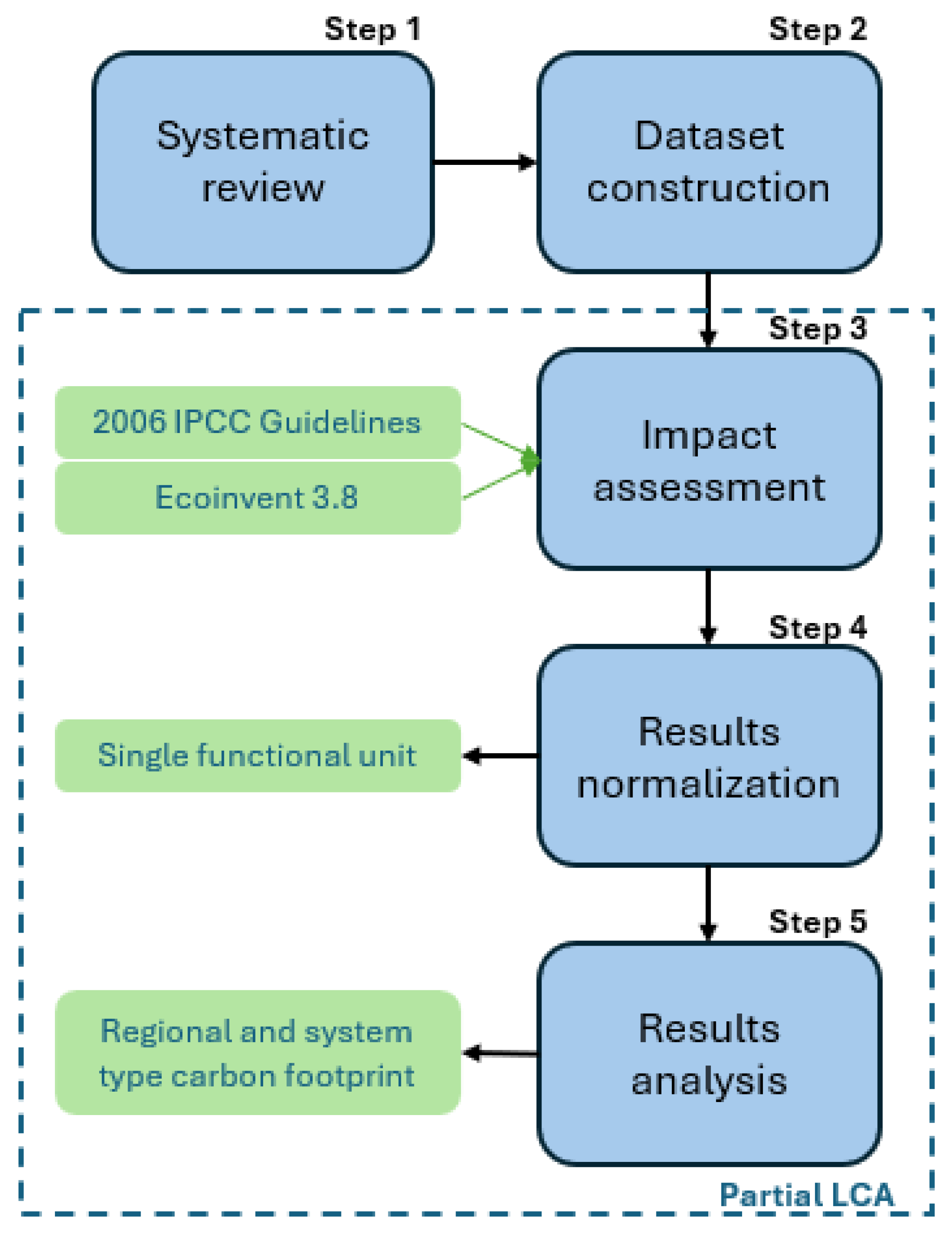
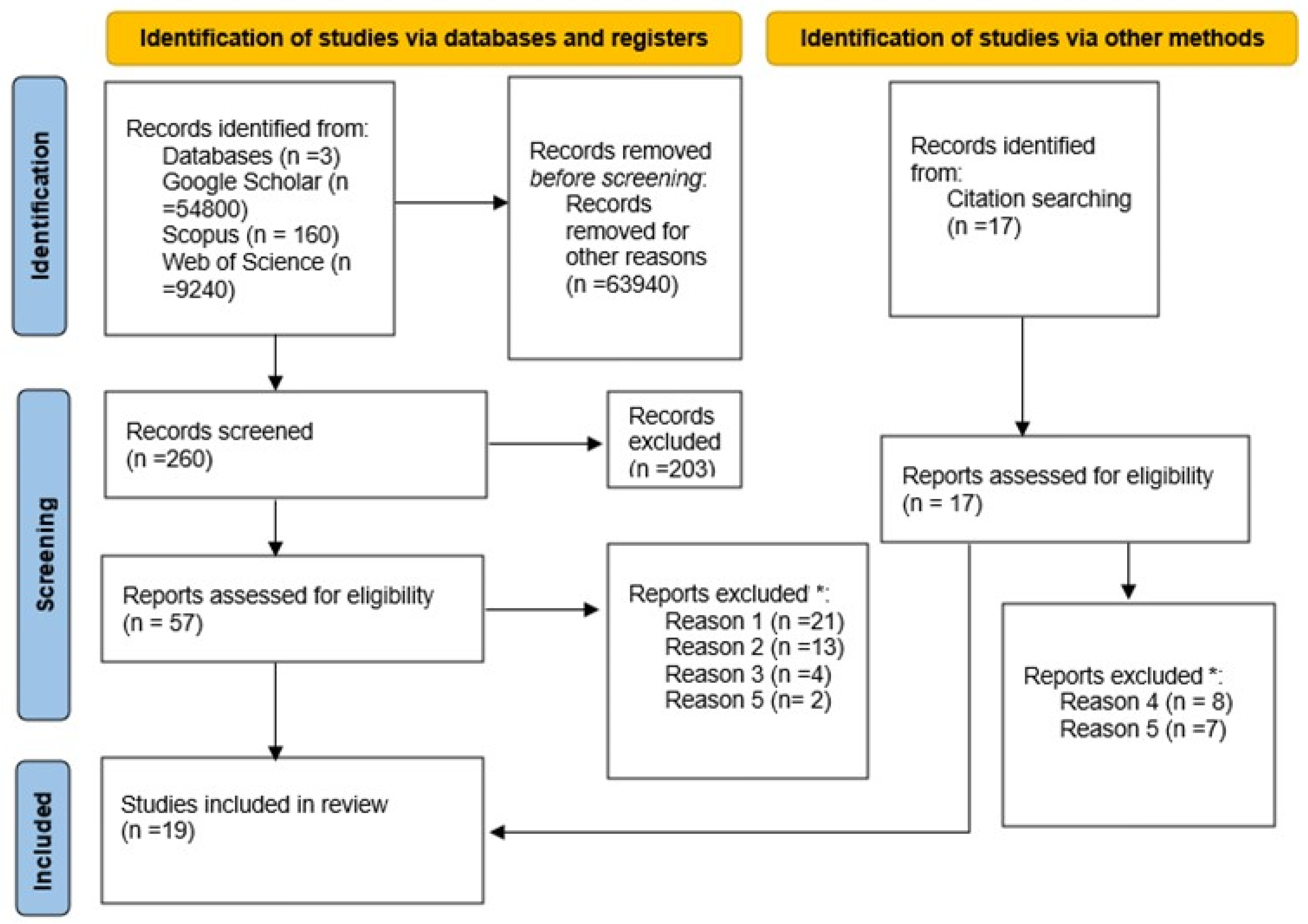

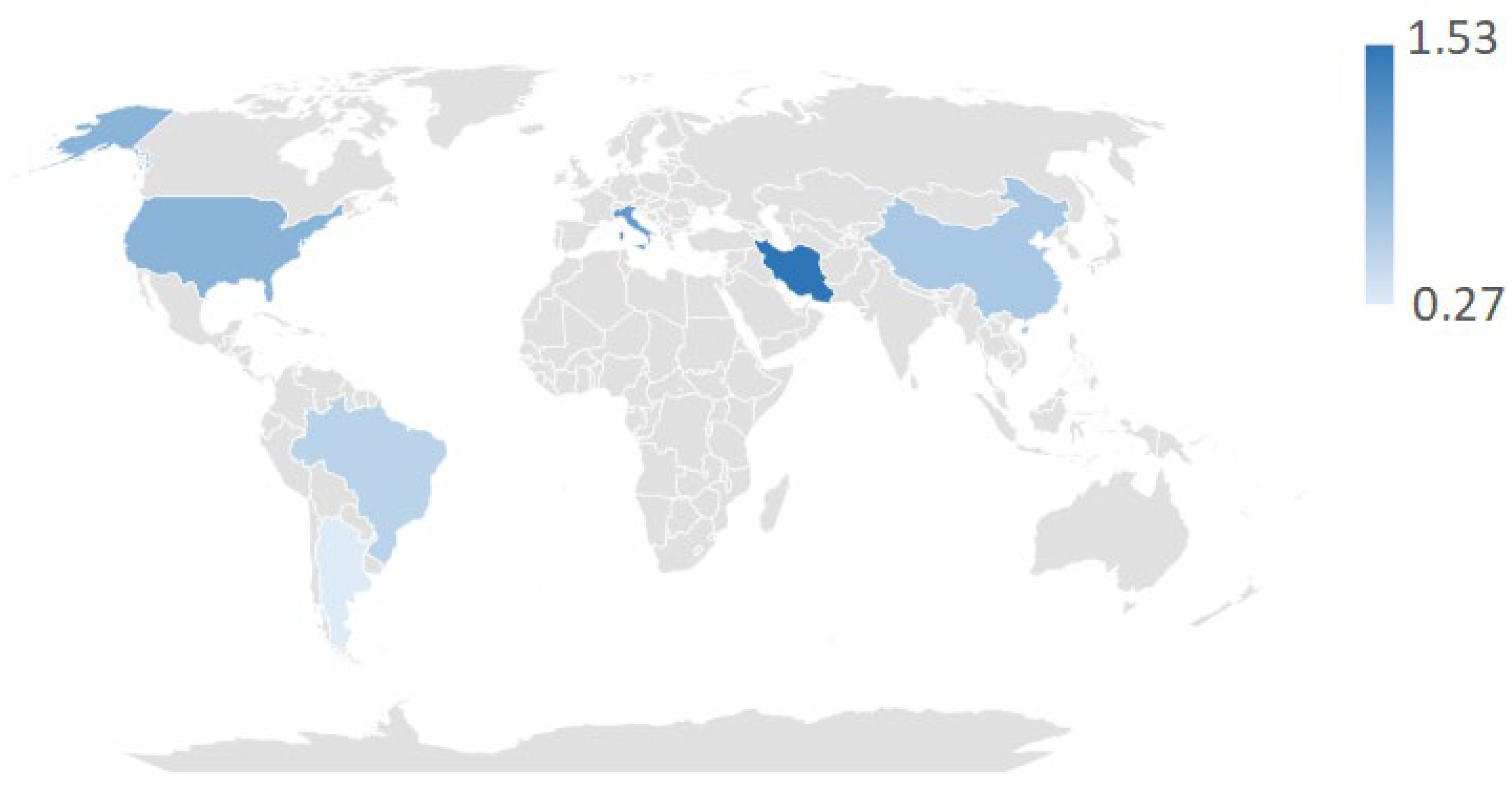
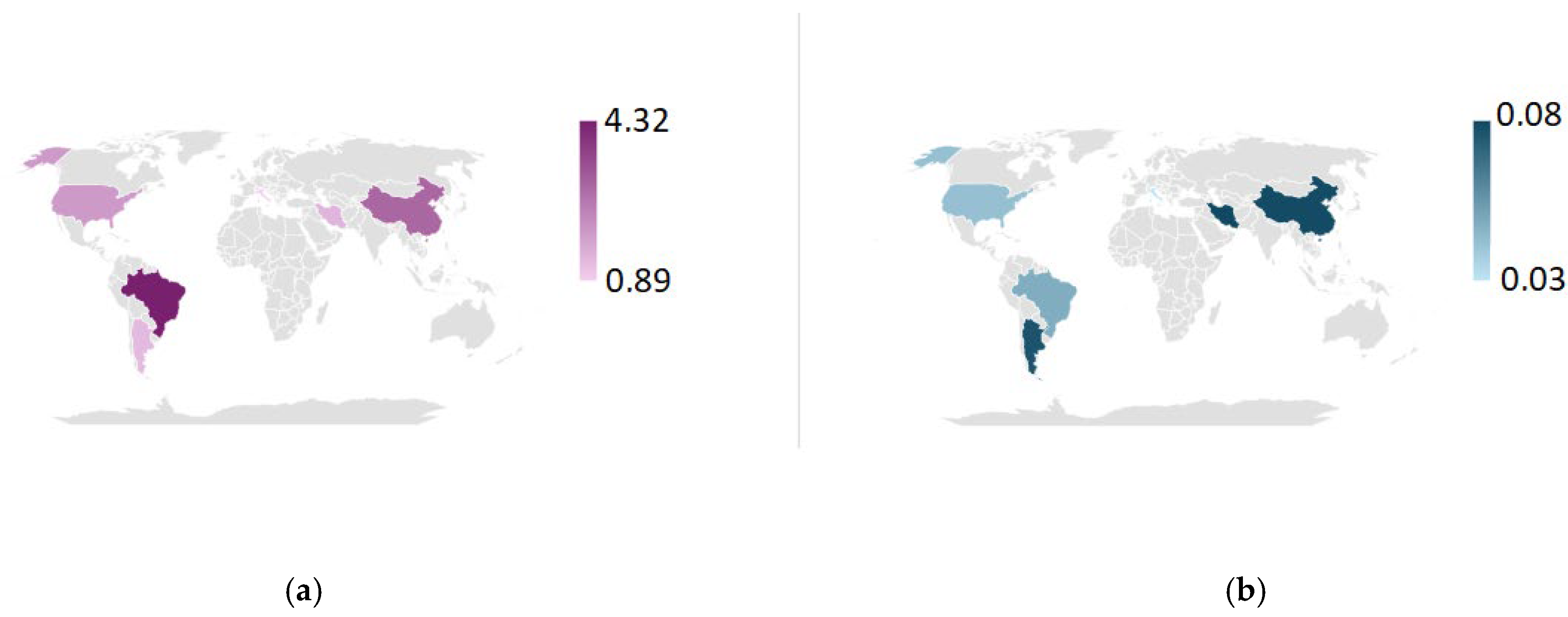
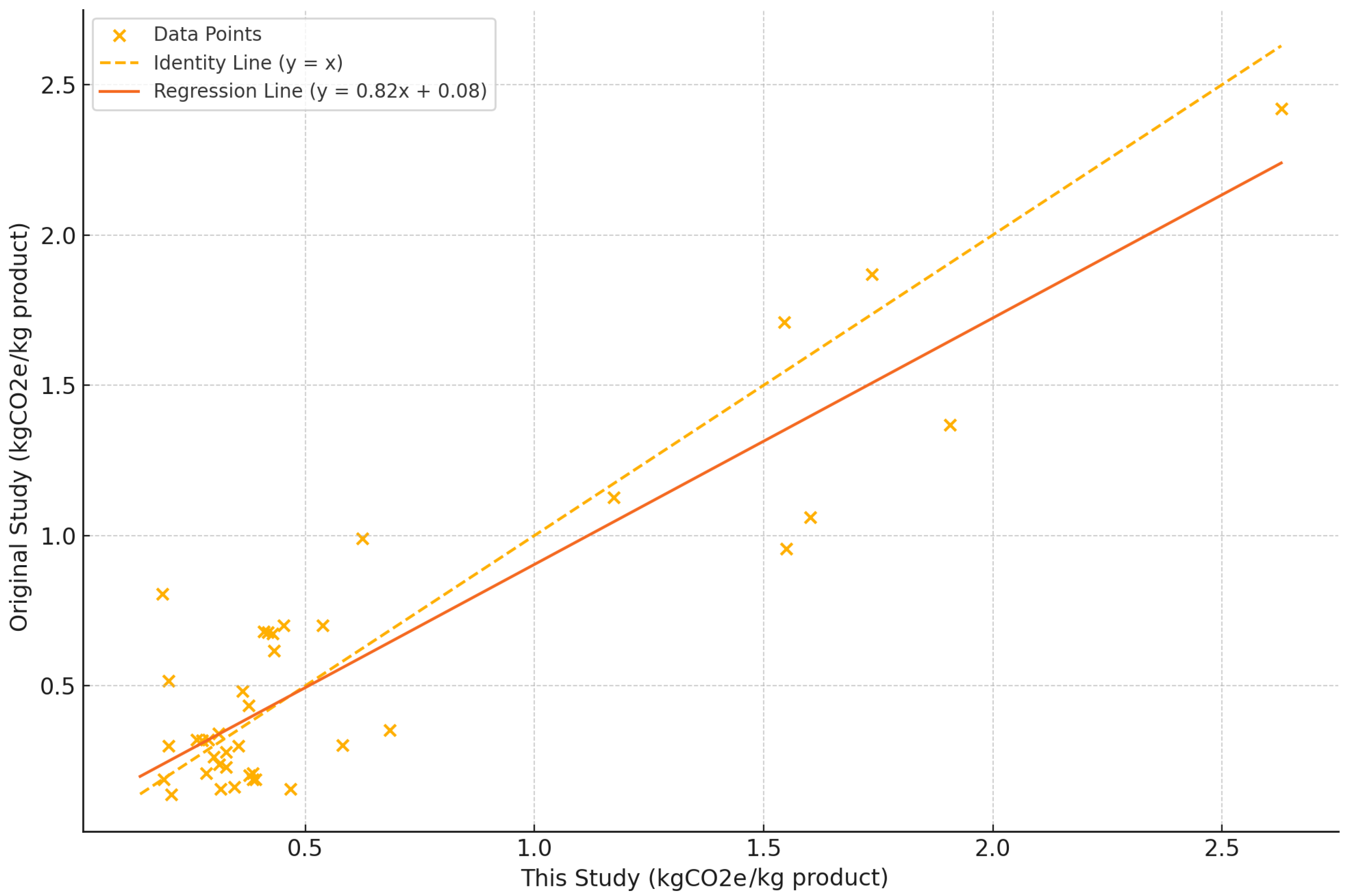
Disclaimer/Publisher’s Note: The statements, opinions and data contained in all publications are solely those of the individual author(s) and contributor(s) and not of MDPI and/or the editor(s). MDPI and/or the editor(s) disclaim responsibility for any injury to people or property resulting from any ideas, methods, instructions or products referred to in the content. |
© 2025 by the authors. Licensee MDPI, Basel, Switzerland. This article is an open access article distributed under the terms and conditions of the Creative Commons Attribution (CC BY) license (https://creativecommons.org/licenses/by/4.0/).
Share and Cite
Lucić, R.; Raposo, M.; Chervinska, A.; Domingos, T.; Teixeira, R.F.M. Global Greenhouse Gas Emissions and Land Use Impacts of Soybean Production: Systematic Review and Analysis. Sustainability 2025, 17, 3396. https://doi.org/10.3390/su17083396
Lucić R, Raposo M, Chervinska A, Domingos T, Teixeira RFM. Global Greenhouse Gas Emissions and Land Use Impacts of Soybean Production: Systematic Review and Analysis. Sustainability. 2025; 17(8):3396. https://doi.org/10.3390/su17083396
Chicago/Turabian StyleLucić, Rahela, Mariana Raposo, Alina Chervinska, Tiago Domingos, and Ricardo F. M. Teixeira. 2025. "Global Greenhouse Gas Emissions and Land Use Impacts of Soybean Production: Systematic Review and Analysis" Sustainability 17, no. 8: 3396. https://doi.org/10.3390/su17083396
APA StyleLucić, R., Raposo, M., Chervinska, A., Domingos, T., & Teixeira, R. F. M. (2025). Global Greenhouse Gas Emissions and Land Use Impacts of Soybean Production: Systematic Review and Analysis. Sustainability, 17(8), 3396. https://doi.org/10.3390/su17083396






